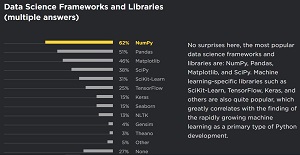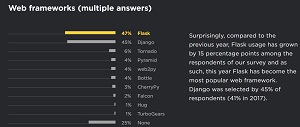News
Python Survey: Data Analysis Overtakes Web Development as No. 1 Use Case
- By David Ramel
- February 7, 2019
A new developer survey about Python reveals the programming language is now used primarily for data analysis, supplanting the previous No. 1 use case, Web development.
Conducted by the Python Software Foundation and developer tools vendor JetBrains, the Python Developers Survey 2018 polled more than 20,000 developers from more than 150 countries last fall, resulting in this key takeaway: "Data analysis has become more popular than Web development among Python users, growing from 50 percent in 2017 to 58 percent in 2018."
The above numbers are combined for scenarios in which Python was reported used as either the primary or secondary programming language used. Among respondents who reported Python is their primary language, 54 percent reported it was for Web development last year, while 51 percent said it was for data analysis (multiple responses allowed). For 2018, those numbers are 59 percent for data analysis and 56 percent for Web development. Among Python devs using Python as their secondary language, DevOps has overtaken Web development.
Among data developers, NumPy, Pandas, Matplotlib and SciPy are reportedly the most popular data science frameworks and libraries in use. "Machine learning-specific libraries such as SciKit-Learn, TensorFlow, Keras and others are also quite popular," the report said.
 [Click on image for larger view.]
Data Science Frameworks and Libraries (source: Python Software Foundation)
[Click on image for larger view.]
Data Science Frameworks and Libraries (source: Python Software Foundation)
In the Web camp, Flask and Django are the most popular frameworks. "Having equal shares (around 45 percent each), they leave other Python Web frameworks far behind," the report said.
 [Click on image for larger view.]
Web Frameworks (source: Python Software Foundation)
[Click on image for larger view.]
Web Frameworks (source: Python Software Foundation)
Among associated developer tools, the No. 1 choices for different scenarios include:
- Testing frameworks: pytest (46 percent)
- Databases: PostgreSQL (44 percent)
- Object-relational modelers (ORMs): SQLAlchemy (34 percent)
- Big Data tools: Apache Spark (12 percent)
- Continuous Integration (CI) systems: Jenkins/Hudson (25 percent)
- Configuration management: Ansible (20 percent)
- Editors and IDEs: PyCharm Professional Edition (20 percent)
And speaking of the aforementioned primary-vs.-secondary language divide, the report says: "84 percent of Python users in our survey use Python as their main language, while for 16 percent it's their secondary language. In 2017 we had a slightly different distribution: 79 percent specified they used Python as a primary language and 21 percent as secondary."
The survey also revealed that among developers using Python as their main language, about half of them also use JavaScript as a secondary language option. "Python is also frequently used together with HTML/CSS, Bash/Shell, SQL, C/C++ and Java," the report said.
Other key takeaways listed in the report include:
- Python 3 adoption rate is growing fast and is already at 84 percent, while Python 2 is used as the main interpreter by only 16 percent of Python users. That's a huge jump in popularity for Python 3, from 75 percent in 2017.
- AWS is the most popular cloud platform for Python developers, followed by Google Cloud Platform, Heroku, DigitalOcean and Microsoft Azure.
- In 2018, significantly more respondents reported being involved in DevOps (an increase of 8 percentage points compared to 2017).
- PyCharm with its two editions is the most popular tool for Python development. Interestingly enough, VS Code has expanded from 7 percent in 2017 to 16 percent in 2018, making it the second most popular editor for Python development. Other popular editors for Python include Vim, Sublime and Jupyter Notebook.
- Surprisingly, almost two-thirds of Python developers choose Linux as their development environment OS.
The Python Software Foundation said the 2018 survey's pool of respondents is more than twice as large as last year's initial 2017 survey.
"Much like the previous survey, we set out to identify the latest trends and gather insight into how the world of Python development looks," the foundation said in a blog post this week (Feb. 5). "Over twenty thousand developers from more than 150 different countries participated last year to help us map out an accurate, up-to-date landscape of the Python community."
About the Author
David Ramel is an editor and writer at Converge 360.